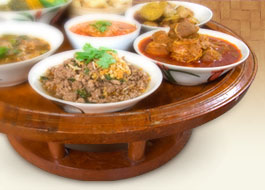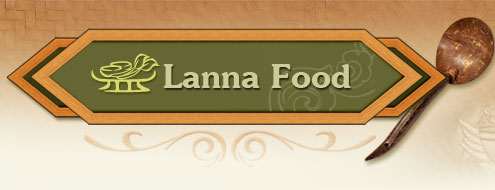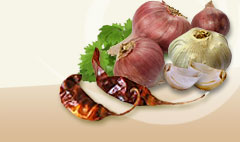Bitter cucumber |
|
|
 | Memordica |
|
| |
 | Cucubiraceae |
|
| |
 | Balsam pear, bitter cucumber, leprosy gourd |
|
| |
 | Ba hoi nok, ba hoi mueang (larger and bitter variety) (Northern) (Rattana Phromphichai, 1999, p. 7540), mara lek, ra (Southern) (Wut Wuthithamwet, 1997, p. 364) |
|
| |
 | Annual climber with tendrils. Stem slender, pubescent. Leaves simple, alternate, lobes ovate, dentate, puberulous. Flowers monoecious, solitary, yellow, 5 petals, obovate. Berry ovoid with rough skin, light green coveced when young, orange when ripe, 2-3.5 cm. in diameter, 5-8 cm long; seeds round or flat or oval with red tissues (Kanchana Diwiset, et al., comp., 2005, p. 187) |
|
| |
 |

100 gm. contains phosphorus 5 mg., beta-carotene, 23 mg. Vitamin C 147 mg. (Phak Phuen Ban Ahan Thai, 2005, p. 222) Young shoots and leaves as well as fruit are blanched or steamed to eat with namphrik of any kind, or added to kaeng khae or khua khae. (Rattana Phromphichai, 1999, p. 7540) |

Leaves: extract can prevent infection of the gall bladder, or can be used as a tonic, an emetic, to relieve fever, inflammation or boils, gall bladder problems, swelling, pain and aches of the joints.
Flowers can be made into a tea to drink to relieve asthma.
Young fruit improves the condition of the gall bladder or bile flow, appetite, general health, menstruation, pancreas, swelling, inflammation, mouth sores and to expel worms, as well as used as a laxative. Dried leaves can be used as a tea to treat diabetes or mixed with tea to reduce the bitter taste. Extract from the fruit can induce an abortion and act as an antivirus or anti-cancer. Young fruit and leaves can improve cold symptoms and treat diabetes, used as anti-HIV, and anti-cancer and anti-toxin and to reduce blood sugar. Ripe fruit is high in saponin and can cause vomiting and diarrhea, so it should not be eaten.
Seeds can expel worms but too much of it can be toxic and produce the same unpleasant effects as the ripe fruit.
Leaves and roots are used to treat diabetes. (Wut Wuthithamwer, 1997, p. 364)
|
|
| |
 | All year round. |
|
| |
 |
Kanchana Diwiset, et al., comp. (2005). Phak Phuen Ban Phak Nuea. Phennapha Sapcharoen, ed. (2nd ed). Nonthaburi: Center for Text Development on Traditional Thai Medicine. (inthai). Phak Phuen Ban Ahan Thai. (2005). Bangkok: Saengdaet. (inthai). Rattana Phromphichai. (1999). Hoi, Ba. inSaranukrom Wattanatham Thai Phak Nuea (Vol. 14,p. 7539-7540). Bangkok: Siam Commercial Bank Foundation for the Encyclopedia of Thai Culture. (inthai). Wut Wuthithamwer. (1997). Saranukrom Samunphrai: Ruam Lak Phesatchakam Thai. Bangkok: Odean Store. (inthai). |
|
| |
|
|




